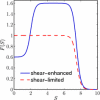Multiphase modelling of the effect of fluid shear stress on cell yield and distribution in a hollow fibre membrane bioreactor
- PMID: 25212097
- PMCID: PMC4349963
- DOI: 10.1007/s10237-014-0611-7
Multiphase modelling of the effect of fluid shear stress on cell yield and distribution in a hollow fibre membrane bioreactor
Abstract
We present a simplified two-dimensional model of fluid flow, nutrient transport and cell distribution in a hollow fibre membrane bioreactor, with the aim of exploring how fluid flow can be used to control the distribution and yield of a cell population which is sensitive to both fluid shear stress and nutrient concentration. The cells are seeded in a scaffold in a layer on top of the hollow fibre, only partially occupying the extracapillary space. Above this layer is a region of free-flowing fluid which we refer to as the upper fluid layer. The flow in the lumen and upper fluid layer is described by the Stokes equations, whilst the flow in the porous fibre membrane is assumed to follow Darcy's law. Porous mixture theory is used to model the dynamics of and interactions between the cells, scaffold and fluid in the cell-scaffold construct. The concentration of a limiting nutrient (e.g. oxygen) is governed by an advection-reaction-diffusion equation in each region. Through exploitation of the small aspect ratio of each region and asymptotic analysis, we derive a coupled system of partial differential equations for the cell volume fraction and nutrient concentration. We use this model to investigate the effect of mechanotransduction on the distribution and yield of the cell population, by considering cases in which cell proliferation is either enhanced or limited by fluid shear stress and by varying experimentally controllable parameters such as flow rate and cell-scaffold construct thickness.
Figures







Similar articles
-
A multiphase model for chemically- and mechanically- induced cell differentiation in a hollow fibre membrane bioreactor: minimising growth factor consumption.Biomech Model Mechanobiol. 2016 Jun;15(3):683-700. doi: 10.1007/s10237-015-0717-6. Epub 2015 Aug 15. Biomech Model Mechanobiol. 2016. PMID: 26276678
-
Multiphase modelling of the influence of fluid flow and chemical concentration on tissue growth in a hollow fibre membrane bioreactor.Math Med Biol. 2014 Dec;31(4):393-430. doi: 10.1093/imammb/dqt015. Epub 2013 Sep 13. Math Med Biol. 2014. PMID: 24036069
-
Mathematical modelling of cell layer growth in a hollow fibre bioreactor.J Theor Biol. 2017 Apr 7;418:36-56. doi: 10.1016/j.jtbi.2017.01.016. Epub 2017 Jan 12. J Theor Biol. 2017. PMID: 28089874
-
Mathematical modelling of fibre-enhanced perfusion inside a tissue-engineering bioreactor.J Theor Biol. 2009 Feb 21;256(4):533-46. doi: 10.1016/j.jtbi.2008.10.013. Epub 2008 Oct 25. J Theor Biol. 2009. PMID: 19014952
-
Computational fluid dynamics for improved bioreactor design and 3D culture.Trends Biotechnol. 2008 Apr;26(4):166-72. doi: 10.1016/j.tibtech.2007.11.012. Epub 2008 Feb 7. Trends Biotechnol. 2008. PMID: 18261813 Review.
Cited by
-
Shear bioreactors stimulating chondrocyte regeneration, a systematic review.Inflamm Regen. 2019 Aug 8;39:16. doi: 10.1186/s41232-019-0105-1. eCollection 2019. Inflamm Regen. 2019. PMID: 31410225 Free PMC article. Review.
-
Regenerative medicine meets mathematical modelling: developing symbiotic relationships.NPJ Regen Med. 2021 Apr 12;6(1):24. doi: 10.1038/s41536-021-00134-2. NPJ Regen Med. 2021. PMID: 33846347 Free PMC article. Review.
-
Soft bioreactor systems: a necessary step toward engineered MSK soft tissue?Front Robot AI. 2024 Apr 22;11:1287446. doi: 10.3389/frobt.2024.1287446. eCollection 2024. Front Robot AI. 2024. PMID: 38711813 Free PMC article. Review.
-
Mathematical modelling of fluid flow and solute transport to define operating parameters for in vitro perfusion cell culture systems.Interface Focus. 2020 Apr 6;10(2):20190045. doi: 10.1098/rsfs.2019.0045. Epub 2020 Feb 14. Interface Focus. 2020. PMID: 32194930 Free PMC article.
References
-
- Akimoto S, Mitsumata M, Sasaguri T, Yoshida Y (2000) Laminar shear stress inhibits vascular endothelial cell proliferation by inducing cyclin-dependent kinase inhibitor . Circ Res 86(2):185–190. doi:10.1161/01.RES.86.2.185 - PubMed
-
- Bancroft GN, Sikavitsas VI, van den Dolder J, Sheffield TL, Ambrose CG, Jansen JA, Mikos AG. Fluid flow increases mineralized matrix deposition in 3D perfusion culture of marrow stromal osteoblasts in a dose-dependent manner. PNAS. 2002;99(20):12600–12605. doi: 10.1073/pnas.202296599. - DOI - PMC - PubMed
-
- Byrne DP, Lacroix D, Planell JA, Kelly DJ, Prendergast PJ. Simulation of tissue differentiation in a scaffold as a function of porosity, Young’s modulus and dissolution rate: Application of mechanobiological models in tissue engineering. Biomaterials. 2007;28(36):5544–5554. doi: 10.1016/j.biomaterials.2007.09.003. - DOI - PubMed
Publication types
MeSH terms
Substances
LinkOut - more resources
Full Text Sources
Other Literature Sources

